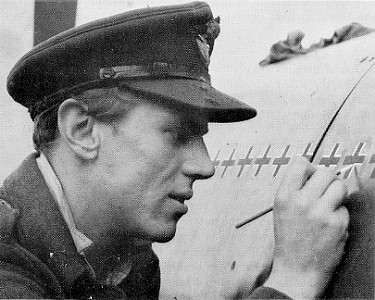
George Beurling was born in Verdun,
Quebec in 1921. His parents had high hopes for George, wanting him to go
to University and study medicine.
Mostly George wanted only to fly,
"Ever since I can remember, airplanes and to get up in them into the
free sky had been the beginning and end of my thoughts and ambitions".
This was borne out in his school marks,
which were barely above passing. He had taken his first flight by age 9,
and hung around LaSalle Road airport outside of Verdun every chance he
got. He often made the chances, skipping school to watch airplanes and do
odd jobs for the mechanics. When he was sent to his room he spent hours
building model airplanes. He sold these creations and used the money to
buy flying lessons. The only books he was interested in were about flying,
especially tales about the WWI aces. He studied the tactics and aerial
battles of WWI, discussing them and arguing with anyone who had the time.
Other kids bullied him because of his obsession with flying, and when he
was chased home one day his father bought boxing gloves and taught to
fight. He also said, "George I don't want you to look for a fight, but I
don't want you to run away."
His home life made a distinct impression
on him and his personality. His father was a devout Presbyterian church
goer, but something early in his adult life made him switch allegiance to
a stern Evangelical sect called the Exclusive Brethren. They had absolute
faith in the Bible. For the Beurlings there were daily bible studies,
frequent reading of the Scriptures and weekly attendance at church. The
Brethren were dead set against pleasures of the flesh, or for that matter,
most other pleasures. It took years before they got a radio, and tobacco
and alcohol were shunned. To that end, George never did take up drinking,
smoking or swearing.
Still, George managed to have fun in and
around Verdun and on his relative's farm. He was athletic and became a
good swimmer, although he didn't participate in team sports.
One day at the Verdun airport, one of
the pilots offered to take him up for a spin in an airplane if he got his
parent's permission. He rushed home and asked them. His mother jokingly
said, "Sure George, you can go to the moon." He got his first flight and
was totally hooked on flying. He first took the controls of an airplane
when he was 12, and soloed in the winter of 1938. He saved up enough money
to afford a weekly lesson, but it was too slow for him. He quit school in
grade 9 and left home, taking a train to Gravenhurst, Ontario. There he
got a job hauling air freight into the bush for mining companies. It was
dull work, but he got many hours of flying time logged and was responsible
for navigating as co-pilot, building up a great store of practical
experience in "seat-of-the-pants" flying. After getting his pilots license
he headed west to Vancouver hoping to get a commercial license. Then he
planned to join the Chinese air force flying against the Japanese invading
Manchuria.
Beurling tried everything that came
along his way that had anything to do with flying. In Edmonton he joined a
flying competition that included several RCAF pilots. He won the event. He
was anything but humble on receiving the prize. He told the crowd that if
the pilots from the RCAF was the best Canada could do, then they were in
trouble. Several years later when he was rejected by the RCAF, he
attributed the rejection to his comments in Edmonton, and carried a chip
on his shoulder for the rest of his life.
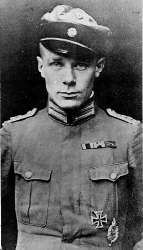
Beurling
often claimed that the WWI German ace, Ernst Udet, taught him how aerial
combat manoeuvres. However, it simply wasn't true. In the mid-thirties
Udet was in California flying as a stunt pilot in Holleywood, but he had
left for Germany and the newly founded Luftwaffe by the time Beurling was
flying.
While trying to get to China George
snuck into the U.S.A. on a tramp steamer and was caught. He was thrown
into jail for two months and then released. By then WWII was on and George
went into the first RCAF recruiting post and presented himself for duty,
but his poor academic record got him booted out of the recruiting station.
He took this to be a personal slight because he had made remarks against
RCAF pilots in Edmonton. However, the RCAF at the time were very small,
under equipped in aircraft and at the time were accepting only pilots with
good educations. These men founded the core of the British Commonwealth
Air Training Plan, teaching others to fly for combat.
As the Russians and Fins were in battle
against each other he decided to head to Europe and join the Finnish air
force fighting against the Russians. The Finnish embassy in Montreal
insisted on his parents permission as he was still only 18. His parents
refused to give it.
Determined to get into the fighting he
signed onto a munitions ship, the Valparaiso going to England, a
sign of real desperation. The trip over was very hazardous as the German
U-Boats were highly active in the north Atlantic, sinking ships at will.
Once in Glasgow he went to the RAF recruiting office. They were impressed
with his flying abilities, but told him that they would need a birth
certificate before they would sign him. Unfortunately, George hadn't
brought his birth certificate along. Off back across the Atlantic he went
for the document, surviving a direct torpedo hit on his ship. And then
back again to England. This time the English signed him immediately.
The
Channel Front
Beurling was sent to a large training
school in the north of England for a short time, as he was already a
licensed pilot. The next stage of training a fighter pilot was to an
Operational Training School (OTS) flying Supermarine Spitfires. He studied
under the ace Ginger Lacy, who was eventually renowned for shooting down
30 Germans, including the Heinkel 111 bomber that had hit Buckingham
Palace.
Beurling got his first taste of warfare
while on leave to London. During an air raid he was astounded by seeing a
little girl playing with a doll while bombs fell nearby and shrapnel
screamed through the air. Rushing to her, he saw her arm had been blown
off, and she was in shock. He scooped her up and carried her to an aid
station. Another girl was pinned in a basement room while water from a
ruptured main filled it. A doctor hurriedly amputated her leg and carried
her to safety. These incidents hardened the naive Beurling. Up to then he
had thought that the war was a great adventure for those who could fly.
In the final stages of fighter training
he astounded instructors with his air-to-air gunnery, consistently scoring
direct hits on the drogue targets. Ginger Lacy offered him a commission on
the spot, but perhaps distrusting officers, or more likely due a lack of
self confidence, he turned it down. He announced that he preferred to live
with the Sergeant Pilots. Once posted to 403 Sqdn, RCAF he was again
offered a commission, and he again turned it down.
He apparently felt that he had more in
common with the NCOs and enlisted men on the base than with the officers.
He was quite popular with the fitters and riggers that looked after his
aircraft, as he took an interest in the aircraft and their work. He would
take them up in the squadron hack, a Miles Magister, for aerobatic
displays. He also occasionally joined them in pubs, although he drank only
soft drinks, and their quarters for bull sessions afterwards.
His fitter, George Demare, tells of an
incident when he flew with Beurling.
My
excitement began with a routine takeoff followed by our buzzing of a
rugby game in progress. Down over the goal posts we flew, causing the
startled players to hug the ground, then up over the other goal posts
and away. Next we swooped down over a herd of cattle, then over a potato
field so low we had to climb to clear the hedge at the far end. More
excitement was provided by flying between two trees with inches to
spare. Following those low-level escapades, it was up into the skies
with a spiral climb, then a variety of loops, turns, stalls, and spins.
For the grand finale Beurling took us into a power dive - straight down
at a horrendous speed. Alas! the ground was so near I abandoned all
hope. Then less than 100 feet from the ground Beurling executed a
vertical hairpin turn and we were sky bound again. After a few more
aerial manoeuvres we came in for a smooth landing. When I emerged
smiling, Beurling patted my shoulder and said "Good flying!"
These activities gained him his first
nickname "Buzz".
His commanding officer placed him in the
Tail-End-Charlie position. At this time the British were still flying in a
flight of 4 aircraft, with three flying in a V, and with one aircraft
flying behind and slightly above the others. This pilot was to weave back
and forth inside the V watching for the enemy behind them. It was nearly
impossible to maintain this position, while weaving and looking out for
enemy aircraft. The Tail-End-Charlie frequently did not make it back to
base as the Germans attacked him first. It was a seriously flawed tactic
that the English eventually abandoned, but it cost many pilots their
lives. The Germans used a loose finger-four formation, with two planes
flying as a pair. They could see behind each other and attack targets as
well. One day in March, 1942 on a sweep over northern France in Spitfire
Vs, George recalled: "we were in the air, our tails in the sun, vulnerable
to attack, when I reported Huns." However, nothing was visible. He was
told to maintain radio silence! "Five minutes later we got bounced and I
got shot." Disregarding instructions he pulled out of formation with three
Focke-Wulf 190s on his tail. His engine hood was shot away, a shell
splinter grazed his ribs and he figured himself for dead meat, when he got
an idea. He dropped his landing gear and flaps, slowing instantly, and the
Germans overshot him. Now being in a poor position they sped away to their
base. On returning to base he lit into his commanding officer in front of
everyone. While justified, it showed poor discipline on his part. Shortly
after he was transferred to 41 Squadron, RAF.
He had more problems with his new
commanding officer, but he downed his first German. At 24,000 ft over
Calais, five FW-190s attacked him while in the Tail-End-Charley position.
Cannon shells slammed into his wings knocking out his own cannons. Again,
cunning saved his hide. He pulled straight up into the sun, the FW-190s
followed and shot past him, as they had more speed, having just pulled out
of a dive. As they climbed past him, he lined up on the middle plane and
fired his four 0.303 Browning machine guns. A German aircraft exploded,
tearing off the wings and splitting the fusilage. Back on the ground he
was chewed out for breaking formation! Beurling responded.
"Six
of us broke formation, five Jerries and I".
Yet again, two days later, over Calais
he was in the Tail-End-Charlie position when he spotted a flight of 190s
below them and heading their way. The rest of the flight ignored his
warnings, as usual. This time he didn't wait to be on the receiving end of
the German's cannons. He peeled out of formation and dove on the Germans,
scoring a perfect deflection shot on the lead plane. It fell away smoking
and crashed into the sea. Once again he was reprimanded for disobeying
orders by leaving formation. Disgusted with the crass stupidity of his
commanding officers, he offered to take the place of a married pilot who
didn't relish being posted to Malta, and was promptly granted permission
to leave.
Malta
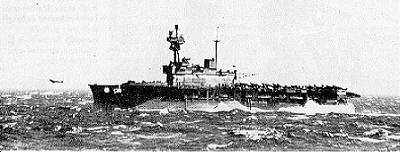
HMS Eagle Flying Off Spitfires
Getting to Malta was problematic, as the
Germans and Italians were trying to cut it off and pound it to pieces. Any
ship getting within range of Axis bombers flying from Sicily were in grave
danger and German U-boats prowled the waters. The 16 new Spitfire Mk Vs
and their pilots destined for Malta were shipped in the aircraft carrier
HMS Eagle. When they were within flying range of Malta (600 miles) the
pilots were given instructions on the heading and approximate distance to
the island and flew off the deck of the Eagle. This was difficult to do as
the Spitfire was never designed for this. The technicians onboard Eagle
put wedges in the flaps to hold them at 50% (Spitfires had only 2 flap
settings, full up and full down), then the pilots had to rev their engines
to the max while standing on their brakes. The deck officer waited until
the Eagle rose on a wave and signalled them off. Once off the deck the
Spitfire would drop close to the ocean before flying. Once altitude was
gained, the pilots dropped flaps all the way, the wedges fell out and then
retracted their flaps. The Germans did their best to confuse the new
pilots by giving false instructions in English, but most pilots were not
fooled by this ruse. Beurling had just landed in his brand new Spitfire,
when the cockpit hood was whipped back, the ground crew pulled him out and
another pilot climbed into the cockpit. As soon as it was refuelled and
armed it roared off to confront an inbound flight of Axis fighters and
bombers. He had landed in the middle of an air raid. Many Spitfires were
destroyed on the ground before they had a chance to get into the fight.
His commanding officer of 249 Squadron
RAF on Malta was S/L Stanley Grant, with FL Laddie Lucas his flight
commander. He proved to be a good judge of character. He said of George,
"Beurling
was untidy, with a shock of fair, tousled hair above penetrating blue
eyes. He smiled a lot and the smile came straight out of those striking
eyes. His sallow complexion was in keeping with his part Scandinavian
ancestry. He was high strung, brash and outspoken. He was a rebel, yes;
but I suspected that his rebelliousness came from some mistaken feeling
of inferiority. I judged that what Beurling needed most was not to be
smacked down but to be encouraged. His ego mattered very much to him,
and from what he told me of his treatment in England, a deliberate
attempt had been made to assassinate it. I made him a promise that I
would give him my trust and that if he abused it he would be on the next
aircraft out of Malta. When I said all this those startling blue eyes
peered incredulously at me as if to say that, after all his past
experience of human relations, he didn't believe it. He was soon to find
out that a basis for confidence and mutual trust did exist. He never
once let me down."
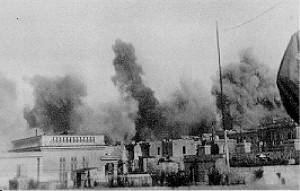
He arrived at the height of the
siege of Malta by the German Luftwaffe and Italian Regia Aeronautica.
They were pounding the island night and day to blast it into
submission. Malta was the perfect location to stage interception raids
on Axis ships trying to reinforce General Rommel in North Africa.
Their main airbase, Takali Field, was a shambles. There was a small
shack for an ops room, the revetments for aircraft were made of broken
rock and sandbags, and slit trenches abounded. It was blinding white
and hot as Hades in the day. Every morning the operational pilots
would have to go out and sit in their aircraft on 1 minute notice. As
the sun rose higher the all metal fighters heated up like ovens, with
a scantily clad pilot sweating in it.
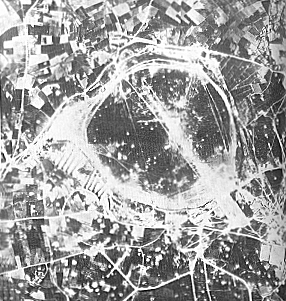
A German photo of Takali Airfield
"On the 12th I got my first real feel of Malta action
when Raoul Daddo-Langlois - "Daddy Longlegs" - and Berkeley-Hill, Jack
Rae and I were sent up to intercept 15 Me 109s. The enemy planes split
us and Berkeley-Hill and I found ourselves alone. About four Jerries
jumped B-H, and I pulled up sharply under one and blew his tail off. He
went down vertically. Nobody saw him hit the deck, but Berkeley-Hill had
seen my burst hit so I was credited with a damaged."
"In those moments of combat I proved to myself that I
had the stuff to match flying and shooting with the gentlemen from
Sicily. That's what I wanted to find out. As we walked away from our
Spits, Daddy Longlegs grinned and said: "Good show, Beurling!" I felt
swell."
During the following lull in fighting
Beurling made copious notes in a black book that he carried with him. In
it, he made detailed calculations on the angles, speeds and shots that he
had made and missed so he could work out how to hit the target the next
time. He developed a set of equations that he committed to memory that
allowed him to perfect the art of the deflection shot. Deflection shooting
was difficult at that time as the Spitfire V had only a ring and bead for
an aiming device. Learning how to lead a plane so your shells hit the same
space as the aircraft did at the same time was tricky to learn. Many never
did, but he mastered it.
On July 6 he got to put into practice
what he had learned when 8 Spits were sent to intercept 3 Italian Cant
bombers heading for Malta. They were escorted by no less than 30 Macchi
200 fighters. Beurling led the assault diving straight through the Macchi
formations and pulling up to fire on a big, Cant bomber. His first burst
hit the pilot blowing off his head, the second took out an engine. Despite
the damage, it made it back to base in Sicily flown by the bomber
aimer/observer. Beurling turned quickly and fired directly into an Italian
fighter, knocking it down in flames. He lined up another Italian fighter
but it dove sharply to get away. Beurling followed all the way from 20,000
feet to 5,000. The Italian had no choice but to pull up and George caught
him square in his sights. The Macchi blew up. Later the same day he led an
attack on 2 Junkers Ju-88s escorted by 20 Bf-109s. A wild dogfight broke
out and 2 German fighter pilots headed right for Beurling. He circled
tightly and caught a 109 with a long burst from 800 yards and at a nearly
impossible angle. He hit the fuel tanks and it went down in flames. In one
day he increased his kill to 5 and became an ace. Back at base the other
pilots snubbed him by not throwing an acknowledgement party of his ace
status. He was only interested in attacking Germans. He admitted that he
was a loner, but Lucas explained to him in simple, direct language that if
he didn't fly as a team, he would be posted into the desert at some even
more God-awful post than Malta. George flew with his wingman as well as he
was able, however, over Malta most dogfights ended up being a single
Spitfire against many enemy aircraft.
It was on Malta that he received his
second nickname, "Screwball". Lucas recounts,
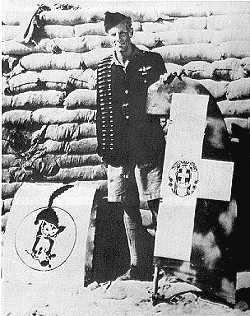
"His desire to exterminate was first made manifest in a curious
way.
One morning, we were on readiness at Takali, sitting in our
dispersal hut in the southeast corner of the airfield. The remains
of a slice of bully-beef which had been left over from breakfast lay
on the floor. Flies by the dozen were settling on it ..."
Beurling pulled up a chair. He sat there, bent over this moving
mass of activity, his eyes riveted on it, preparing for the kill.
Every few minutes he would slowly lift his foot, taking particular
care not to frighten the multitude, pause and - thump! Down would go
his flying boot to crush another hundred or so flies to death. Those
bright eyes sparkled with delight at the extent of the destruction.
Each time he stamped his foot to swell the total destroyed, a
satisfied transatlantic voice would be heard to mutter "the goddam
screwballs!"
So George Beurling became "Screwball" to 249, to Malta and to the
world. It was an endearing appellation. It suited him exactly.
What's more he like it. It helped his ego. It made him feel he was
now regarded as an established member of the team. He felt the gaze
beginning to be focused on him. At last he was a figure in his own
right....
George took to hunting the ubiquitous lizards around Takali airfield
with his .38 pistol. He would go out alone and stand motionless waiting
for a lizard to get within a prescribed range where he estimated they were
roughly the size of a German fighter at 250 yards. This was his preferred
range for firing. He often hit the lizards with a single bullet. He was
completely focussed on being the best fighter pilot that he could be.
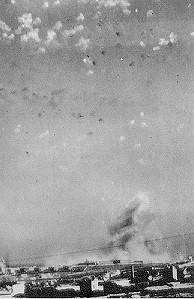
Malta
was a hectic station, with frequent, large scale raids by Germans and
Italians. But the AA gunners on Malta quickly became the most proficient
in the world with the constant practice they had. Many Axis aircraft were
knocked down by the islands ground defences, as well as the Spitfires. By
July 11 he had shot down two Bf-109s, three Macchi 202s, had a probable
kill on a 109 and damaged a Junkers 88 bomber.
His marksmanship had become a legend. He once reported he had fired 5
cannon shells into the cockpit of an enemy plane. Allied soldiers found
the plane with 5 cannon holes in the cockpit. A fellow Spitfire pilot said
of Beurling,
"He was so successful for many reasons, but
the two most important were his eyesight and his knack for deflection
shooting. He used to report sighting of aircraft many seconds before
others saw them, and he knew whether he hit them in the front, centre or
rear of their airplane and he usually used minimum ammunition."
Lucas stated,
"He had an instinctive feel for an aircraft.
He quickly got to know its characteristics and extremes - and the
importance of doing so. He wasn't a wild pilot who went in for all sorts
of hair-raising manoeuvres, throwing his aircraft all over the sky. Not
at all. George Beurling was one of the most accurate pilots I ever saw.
A pair of sensitive hands gave his flying a smoothness unusual in a
wartime fighter pilot ... This acute sensitivity told him that a
Spitfire was only a fine gun platform if it was flown precisely. He
therefore set out to make himself the master of the airplane. He never
let it fly him."
He never shot haphazardly at an aircraft that was too far away. He
liked to fire from about 250 yards with several short, hard bursts. That
was usually enough.
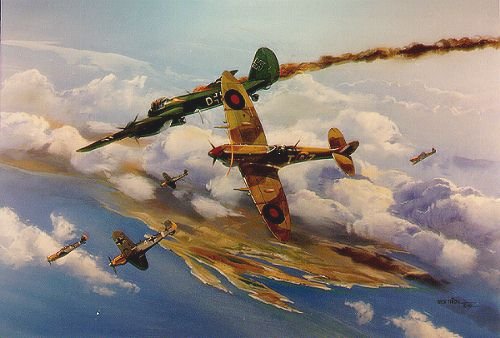
"Fox in the Henhouse"
On July 14 he ended up on the receiving end of some German lead. Three
Bf-109s and 2 Italian Reggiane 2001 fighter/bombers jumped him. He turned
towards the Italians figuring they could do less damage to him, as they
were not equipped with cannons, but his aircraft was shot up pretty bad.
Back at base he counted 23 holes in his aircraft. He got even a while
later downing his first Reggiane and damaging a Ju-88.
Beurling waxed hot and cold on his Italian opponents. In a 1943
interview he referred to the Italians as "ice-cream merchants", saying
"The Eyeties are comparatively easy to shoot
down. Oh, they're brave enough. In fact, I think the Eyeties have more
courage than the Germans, but their tactics aren't so good. They are
very good gliders, but they try to do clever acrobatics and looping. But
they will stick it even if things are going against them, whereas the Jerries will run."
On July 27 Beurling dealt the Italians a hard blow by killing their
leading ace, Captain Furio Niclot and shooting down his wingman, Serg.
Magg. Faliero Gelli. Together they had knocked down 8 Spitfires over
Malta. Gelli never saw him coming, he hit the wingman's radiator and
engine sending him down to crash on an island. He was captured and made a
prisoner and thus survived the war. Niclot was killed outright seconds
later. Beurling was lining up on a third Macchi when two Bf-109s came up
after him. He peeled off and attacked the Germans, hitting the leader in
the fuel tanks and sending him down in flames. He was on a roll. He
landed, refuelled and went back up to attack four Bf-109s. He shot down
one in flames and received credit for a damaged plane that limped out of
the fight smoking badly. For his amazing day's work he received the
Distinguished Flying Medal.
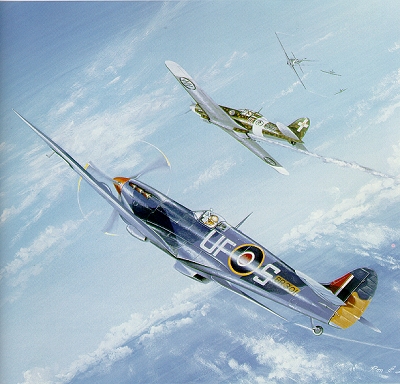
Beurling after Gelli
Near the end of July he shot down another Bf-109, and his superior
officers finally had to promote him to an officer and ordered him to
accept. The press were anxious to interview him, and it wouldn't do to
have the top fighter pilot in Malta be a Sergeant Pilot. So he became a
Pilot Officer, much to his disgust.
He, and many of the surviving pilots, were exhausted by the physical
demands of fighter combat, stress, heat, poor nutrition and a form of
dysentery they called "the Dog". Beurling had lost 50 lbs since arriving
in Malta, the Germans and Italians were close to shutting down the island
by cutting off it's food supplies. He was bed ridden for a week, but
managed to drag himself into the air to battle the Messerschmitts that
circled Malta. Several flights of Bf-109s jumped him. He managed a short
burst that brought down a German, but his comrades shot Beurling's plane
to pieces. He crash landed in a field because his parachute was too loose
for him to jump out. By the end of August he collected a shared victory
over a Ju-88 that had been separated from it's fighter escort.
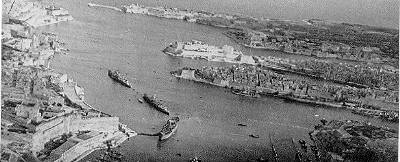
Valletta Harbour
He was again bed-ridden for several weeks due to continued weakness
from the poor quality food. In the middle of September he took a plane up
but got it badly shot up by a German. He took revenge a few days later
when he attacked 18 German fighters. One blew up when he hit the oxygen
bottles, another fell away smoking and a third went down in flames. Then
came October. The Axis powers pulled out all of the stops to crush Malta.
It was a vicious battle, half of Beurling's squad was shot down in one
week. His only close friend, a fellow Quebecer, was killed. After that he
had no more friends, it was easier that way.
The air war over Malta became a real grudge match. Pilots on both sides
were shot in the air while they hung from their parachutes, or while they
floated in the water. Several Italians who landed on Malta were tortured
and killed before the British troops could capture them. Little sympathy
was shown by either side towards their opponents.
By the 14th of October Beurling had shot down 5 more German planes,
three in one day. He should have been awarded the VC for that effort.
Three flights of Spitfires scrambled to intercept 95 Axis planes. Beurling
spotted them first, but his radio died and he couldn't contact the others.
He piled into the Axis formations, damaging a Junkers 88, and downing 2
Bf-109s. Going home he came across a damaged Ju-88 and shot it down.
Actually the huge enemy formations worked in his favour, as the large
number of German and Italian fighters couldn't attack him all at once.
They either got in each other's way or no one attacked him. Like Bishop he
adopted the fast sneak attack and a quick withdrawal method. He could
usually count on damaging or downing the first aircraft he attacked, and
he got out with the resulting confusion. Then he could circle and pick off
stragglers or wait for a favourable chance to attack again.
His last fight over Malta was, as usual, spectacular. He led 8
Spitfires in an attack on 8 Ju-88 bombers and 50 fighters. He cut out a
bomber and shot it down, but the rear gunner hit him in a finger and
forearm. He attacked and damaged a 109 in front of him, but two behind him
shredded his tail and wings with cannon fire. He dove fast for the water,
losing the Germans. Coming out of the dive he spotted a 109 below him and
shot it down. But that attracted attention from more Germans.
"I'd been so intent on the guy in my sights and on Willie's tail that
I'd forgotten I had a tail of my own."
"Just as I shot Willie's pal down, a Messerschmitt nailed me from
behind, right in the belly of the Spit. A chunk of shell smashed into my
right heel. Another went between my left arm and body, nicking me in the
elbow and ribs. Shrapnel spattered into my left leg. The controls were
blasted. The throttle was jammed wide open and there I was in a
full-power spin, on my way down from around 18,000 feet. I threw the
hood away and tried to get out, but the spin was forcing me back into
the seat. "That is it," I said to myself. "This is what it's like when
you're going to die."
I didn't panic. If anything, I was resigned to it. What the hell,
this was the way I'd always wanted to go. Then I snapped out of it and
began to struggle again.
The engine was streaming flame but I managed to wriggle out of the
cockpit and onto the port wing from which I could bail into the inside
of the spin. I was down to 2,000 feet. At about 1,000 I managed to slip
off. Before I dared pull the ripcord I must have been around 500. The
chute opened with a crack like a cannon shell and I found myself
floating gently down, the damnedest experience in contrasts I'll ever
have.
I caught my breath, pulled off a glove and dropped it to get some
idea of the distance between me and the sea. A breeze caught it and the
glove went up past my face. I laughed like a fool, then tugged off my
flying boots and dropped them. Just as I did I hit the water.
He was rescued shortly after by a launch from shore. When they got
there he was floating in blood-stained water babbling about the bible that
his mother had given him. The rescue squad searched his pockets and found
it. He was patched up as well as they could on Malta and spent some time
in hospital before being sent back to Britain.
The flight back was in a Liberator bomber converted to a transport. The
nineteen passengers rode in the bomb bay and fuselage without seats.
George flew along with fellow Canadian ace "Billy the Kid" Williams and
fighter pilot A.H. Donaldson. The aircraft ran into a ferocious thunder
storm near Gibraltar. Low on gas there was no alternate landing strip so,
with poor visibility the pilot forced the bomber down. He couldn't control
the plane well enough on descent into Gibraltar and missed two thirds of
the runway. The aircraft touched down too late and the pilot tried to pull
back up. With the engines at full throttle but not generating enough power
yet they crashed into the water. Beurling said afterwards that he could
tell from the way the plane behaved that it was going to stall so he
opened the emergency door and jumped just as the plane hit the water. He
managed to swim the 160 yds to shore, despite a heavy cast on his foot.
Only Donaldson, Beurling and another passenger survived. Beurling was
hospitalized with shock and an infection in his wounded heel.
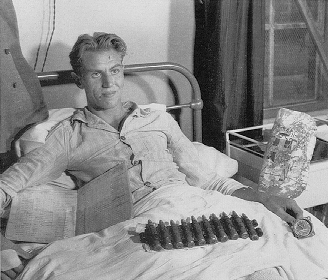
The newsprint media flocked to his bedside in England and printed
everything he said. One reported wrote "here was a youth with hidden
courage".
Rest in Canada
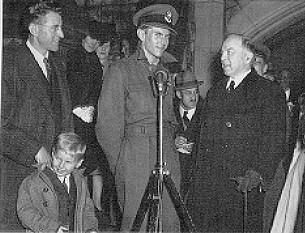
He was sent back to rest in Canada and Prime
Minister Mackenzie King milked his presence with a "photo-op" and
nearly messed everything up by being late. Beurling was worn out after
a 21 hour flight across the Atlantic.
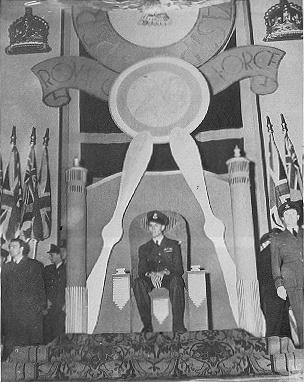
The next day he was given a hero's welcome
parade through Verdun and Montreal. People lined the parade route
despite a cold, slashing rain. Nearly 10,000 people packed the Verdun
arena to see their hometown hero. The CBC sent an announcer to
broadcast the whole spectacle to the rest of Canada. Being big about
it, AC deNiverville, the senior officer for the RCAF No. 3 Training
Command admitted that they made a mistake in not taking Beurling when
he applied.
"This is one of the mistakes that the
RCAF has made, and let us hope we will not make many more like that.
We owe, the Royal Air Force a debt for being wiser than we were and
readily accepting him."
It was then George's turn on the podium. He
spoke for just over four minutes. Opening with
"This is no place for me, I'm a fighter
pilot, not a speech maker."
He continued, apologising for not always looking excited to be in
Victory Loan Drives, but he was exhausted, bewildered and excited. He
had gone in a few weeks from desperate, kill-or-be-killed battle to an
overwhelming, adoring public. He was undoubtedly suffering from battle
fatigue.
The persona that George put forward for the public and the press was
that of a hard-hearted, professional killer. He made statements like this
on dog-fighting:
"I wonder if he is going to blow or fry.
There is no time for any other kind of thought. There is always someone
on your tail and you have to be pretty sharp. There is no time to loiter
around. You have to be hard-hearted too. You must blaze away whenever
you are in a position to get his oxygen bottles or gas tanks."
He gave a press interview that has been retained in the National
Archives of Canada. In it he described a horrifying scene that, according
to his brother David, haunted him in nightmares for years. In it he is
attacking an Italian fighter aircraft.
From Brian Nolan's book Hero, he quotes:
"I came right up underneath his tail. I was
going faster than he was; about fifty yards behind. I was tending to
overshoot. I weaved off to the right, and he looked out to his left. I
weaved to the left and he looked out to his right. So, he still didn't
know I was there. About this time I closed up to about thirty yards, and
I was on his portside coming in at about a fifteen-degree angle. Well,
twenty-five to thirty yards in the air looks as if you're right on top
of him because there is no background, no perspective there and it looks
pretty close. I could see all the details in his face because he turned
and looked at me just as I had a bead on him. One of my can shells
caught him in the face and blew his head right off. The body slumped and
the slipstream caught the neck, the stub of the neck, and the blood
streamed down the side of the cockpit. It was a great sight anyway. The
red blood down the white fuselage. I must say it gives you a feeling of
satisfaction when you actually blow their brains out."
He was undernourished after the starvation diet on Malta, and his wound
in his heel festered. He was secretly admitted to the Royal Victoria
Hospital for several weeks. He was allowed out only for his twenty-second
birthday so he could enjoy his mother's chocolate cake.
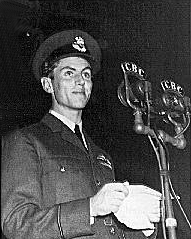
Following a full physical recuperation,
although one foot was permanently shorter than the other, he was sent
to help sell war bonds all across Canada. He made appearances at
flight training schools, army camps and factories. He promoted Victory
Bonds and enlistment. But he was a poor public speaker and he resented
the boring work. When asked by a reporter about it he snapped "if I
were ever asked to do that again I'd tell them to go to hell or else
ask for a commission on the bonds I sold". In March, 1943 he was near
the end of the bond drive in Vancouver. It was there he met Diana
Whittall, the daughter of a respected Vancouver family. They dated,
and went out swimming while he was there. They would marry 14 months
later.
By the spring of 1943 he was fit for duty. He griped that the RCAF was
pressuring the RAF into transferring him, however, it turned out that he
applied for the transfer with a letter to AC deNiverville.
The European Front
After a short stint at sales, he was sent back to England and made a
gunnery instructor at a training base. Unfortunately, he had no patience
to teach others what he was so good at and desperately wanted back into
action. He continually requested the RAF post him to an operational
squadron, but they turned him down. The RAF finally transferred him to the
RCAF in September, 1943. Monty Berger, an Intelligence Officer in 403 RCAF
Squadron, convinced his superiors that Beurling was personable and willing
to help. So Beurling was posted to 403 Squadron again flying from Kenley
in Kent, headed by the Canadian S/L Hugh Godefroy. The famous English ace
Johnny Johnson was WingCo Flying of 127 Airfield at Biggin Hill.
Hugh Godefroy, in his wartime biography "Lucky Thirteen" writes about
many of the famous pilots he led, Beurling included. Of him he wrote:
"Beurling was a tallish slim fellow with a dishevelled crop of blond
hair, sharp features and deep creases down each cheek. He was given to
chewing gum slowly and deliberately with his mouth open. He had large
ice-blue eyes that rarely blinked. With George there was no place for
preambles. I went straight to the point. I outlined the conditions under
which I would accept him into my Squadron. He listened in silence, his
face an expressionless mask. Johnny (W/C Johnny Johnson) then pointed
out that we needed experienced leaders with his capability and that he
wanted him to take charge of the Ground Gunner Programme. There was a
long pause while we both waited. Finally he said:
'Yep, I'll do it!'
'Okay,' I said, 'go on down to the Dispersal hut and meet your
squadron mates and familiarize yourself with the Spitfire IX. You'll
find it a lot different from the V's that you flew before.'
Without a change of expression he turned on his heels and strode out.
'Friendly chap, isn't he?' Johnny chuckled.
Beurling continued to be a mixed up guy. He seemed to specialize in
showing off in bizarre ways, typical of insecure people. He was forever
stunting in the squadron Tiger Moth, and buzzing the airfield or buildings
at low level.
One time W/C Godefroy wrote:
"A wood duck had taken up residence in the
pond and become tame enough to be hand-fed. Buck (Bob Buckham) never
left the dining table without taking him some scraps. "Buzz" Beurling
strolled out of the dining-room and stood for a moment in front of us on
the top step surveying the scene. To our utter amazement, he pulled his
Webley revolver from his holster, took aim at the duck and proceeded to
shoot feathers out of its tail. Before he could fire the third shot,
Buckham was beside him and with a lightning chop knocked the revolver
from his hand. With his eyes burning like two coals of fire, he said
very slowly,
"Beurling, if you ever shoot at that duck again, I'll kill you with
my bare hands!"
Beurling just looked at him with those cold blue eyes, then slowly
his face broke into a grin as he said:
"Okay, Buck, I wasn't going to hurt it."
